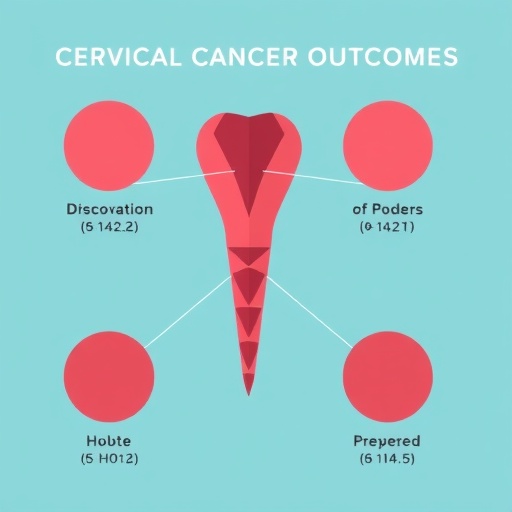
A groundbreaking study published in BMC Cancer introduces a novel prognostic model that could transform the management of cervical squamous cell carcinoma (CSCC) patients undergoing concurrent chemoradiotherapy. Leveraging the advanced lung cancer inflammation index (ALI) alongside other critical clinical factors, researchers have created a powerful nomogram capable of predicting patient outcomes with unprecedented accuracy. This innovation promises to refine personalized treatment strategies and improve survival rates for a disease that remains a leading cause of cancer-related morbidity worldwide.
Cervical squamous cell carcinoma, a major histological subtype of cervical cancer, often presents clinicians with complex challenges due to its variable clinical course and response to treatment. Current prognostic tools largely depend on the American Joint Committee on Cancer (AJCC) staging system, which, while valuable, fails to incorporate the full spectrum of biological and inflammatory markers that influence disease progression. Recognizing this limitation, the research team embarked on a comprehensive investigation to integrate systemic inflammation metrics, comorbidity indices, and tumor burden into a more nuanced risk assessment model.
Central to this new prognostic tool is the advanced lung cancer inflammation index (ALI), an emerging biomarker derived from systemic inflammatory and nutritional status indicators such as body mass index, albumin level, and neutrophil-to-lymphocyte ratio. ALI has previously demonstrated prognostic relevance in lung cancer populations, but its application in cervical cancer had not been fully explored until now. By analyzing the relationship between ALI and survival outcomes, the study illuminates inflammation’s pivotal role in tumor progression and resistance to therapy.
.adsslot_kL3awSsoVx{width:728px !important;height:90px !important;}
@media(max-width:1199px){ .adsslot_kL3awSsoVx{width:468px !important;height:60px !important;}
}
@media(max-width:767px){ .adsslot_kL3awSsoVx{width:320px !important;height:50px !important;}
}
ADVERTISEMENT
The research encompassed a sizable cohort of 243 patients diagnosed with CSCC who underwent concurrent chemoradiotherapy between 2017 and 2023. This extensive patient pool allowed for robust statistical modeling and validation. Utilizing both univariate and multivariate Cox regression analyses, the investigators pinpointed ALI, adjusted Charlson Comorbidity Index (ACCI), AJCC stage, and tumor volume as independent prognostic factors significantly associated with progression-free survival (PFS) and overall survival (OS).
Following the identification of these predictors, the team constructed two separate nomograms—one forecasting progression-free survival and the other predicting overall survival. These nomograms synthesize the weighted contributions of each risk factor, providing an individualized prognostic score for each patient. Such personalized prognostication equips clinicians with an enhanced framework for risk stratification, offering a pathway toward tailored therapeutic interventions aimed at optimizing clinical outcomes.
Validation of the nomograms against both training and independent cohorts attested to their reliability and predictive power. The models achieved concordance indices (C-indexes) of approximately 0.74 for both PFS and OS in the training group, with minimal reduction in validation groups, underscoring the models’ consistency. Notably, these figures surpassed the predictive accuracy of the classical AJCC staging system alone, highlighting the added value of integrating inflammation and comorbidity metrics into existing prognostic paradigms.
Importantly, the study established a three-tier risk stratification based on total nomogram-derived points, delineating patients into high-risk, medium-risk, and low-risk groups. Survival analyses demonstrated statistically significant differences among these subgroups, confirming the clinical utility of the model in distinguishing patients who might benefit from intensified management from those with more favorable prognoses warranting standard care.
The implications of incorporating ALI into cervical cancer prognostic models extend beyond risk assessment. Chronic inflammation has long been implicated in carcinogenesis and tumor evolution, influencing immune evasion and therapeutic resistance. By quantifying systemic inflammatory status through ALI, this nomogram reflects the biological interplay between host factors and tumor behavior more holistically than staging criteria focused solely on anatomical disease extent.
Moreover, the adjusted Charlson Comorbidity Index plays a critical role in this framework by accounting for the burden of concomitant diseases that can impact treatment tolerance and survival independent of the cancer itself. This multidimensional approach resonates with the growing emphasis on holistic patient evaluation, moving toward precision oncology that optimizes outcomes by addressing patient heterogeneity comprehensively.
The study’s methodological rigor, including extensive follow-up periods and external validations, lends credence to the clinical applicability of the nomograms. Nevertheless, the authors acknowledge limitations such as the single-center nature of the cohort and the potential influence of unmeasured confounders. Future research endeavors are encouraged to validate these findings in multi-institutional settings and explore integration with emerging molecular and genomic biomarkers.
This pioneering work heralds a shift in the prognostic assessment of cervical squamous cell carcinoma. By harnessing a composite of systemic inflammation, comorbidity, and tumor parameters, the nomogram offers a sophisticated, evidence-based tool that outperforms traditional staging modalities. As clinicians strive to personalize therapeutic regimens, tools like these not only enable more accurate patient counseling but may also facilitate clinical trial stratification and novel therapeutic targeting.
The integration of ALI into prognostic modeling aligns with broader oncological trends recognizing inflammation as a hallmark of cancer progression and a potential therapeutic target. Incorporating easily measurable, cost-effective biomarkers into routine clinical workflows can democratize precision medicine, especially in resource-limited settings where complex genomic profiling remains inaccessible.
In conclusion, the tailored nomogram based on ALI and pertinent clinical variables represents a significant advancement in cervical cancer management. It underscores the importance of prognostic innovation rooted in pathophysiological insights and highlights the potential for improved survival outcomes through personalized care pathways. As cancer treatment paradigms continue to evolve, models like these will be indispensable in bridging the gap between empirical staging systems and individualized medicine.
Ultimately, this research not only equips clinicians with enhanced predictive capabilities but also reinvigorates the pursuit of integrating systemic biology into oncological prognostication. The path ahead invites further exploration into how inflammatory modulation could synergistically enhance therapeutic efficacy, heralding a new era of comprehensive cancer care centered on the intersection of tumor biology and host response.
With cervical cancer remaining a public health challenge globally, especially in low- and middle-income countries, innovations that refine prognostic accuracy and guide resource allocation are urgently required. This study’s nomogram offers a practical and scientifically grounded approach to meet these needs, signaling hope for improved patient outcomes through smarter, data-driven clinical decision-making.
As the oncology community embraces such tools, the translation of inflammation-based indices from research into clinical practice could become a cornerstone of future cervical cancer treatment algorithms. This exemplifies precision oncology’s promise: integrating diverse data streams to craft treatment plans that reflect each patient’s unique biological landscape, ultimately improving survival and quality of life.
Subject of Research: Prognostic modeling of cervical squamous cell carcinoma using advanced lung cancer inflammation index and clinical factors in patients undergoing concurrent chemoradiotherapy.
Article Title: Nomogram based on the advanced lung cancer inflammation index and other relevant clinical factors for patients with cervical squamous cell carcinoma undergoing concurrent chemoradiotherapy.
Article References:
Wang, XC., Xu, XL., Wang, SY. et al. Nomogram based on the advanced lung cancer inflammation index and other relevant clinical factors for patients with cervical squamous cell carcinoma undergoing concurrent chemoradiotherapy. BMC Cancer 25, 1043 (2025). https://doi.org/10.1186/s12885-025-14465-6
Image Credits: Scienmag.com
DOI: https://doi.org/10.1186/s12885-025-14465-6
Tags: advanced lung cancer inflammation indexAJCC staging limitationsCervical cancer prognosiscervical squamous cell carcinoma treatmentchemoradiotherapy outcomes in cervical cancerimproving survival rates in cervical cancerinflammation index in cancerinflammatory biomarkers in cancer therapynomogram for cancer predictionpersonalized cancer treatment strategiessystemic inflammation metrics in oncologytumor burden assessment in cancer





